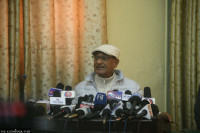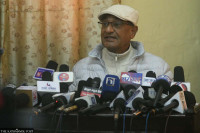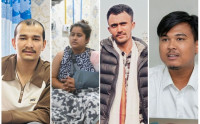National
Uncertainty looms over fate of Machhindranath jatra after rituals halted amid Covid-19 concerns
Residents of Bhaktapur bring up the idea of taking the deity to their town, but organisers are against it.
Srizu Bajracharya
After multiple postponements over the past four months, uncertainty still looms large over the fate of this year’s Rato Machhindranath jatra, one of the oldest festivals of the Valley traditionally organised by the people of Patan (Lalitpur).
The residents of Patan have already built the chariot of Karunamaya, the main deity of the festival, and placed the idol inside the chariot signalling the start of the months-long festival. But they haven’t been allowed to go ahead with the rest of rituals as it involves huge crowds pulling the chariot to various neighbourhoods—a sight public health officials and local authorities dread to imagine amid the Covid pandemic.
After the local guthis of Patan couldn’t organise the festival, which was supposed to start on April 24, the people of Bhaktapur, the other ancient city of the Valley, are now toying with the idea of hosting the rain god, and the festival until the next cycle of rituals begins next year. But the organisers of the jatra are saying that’s not possible.
“It’s one of the old oral stories that we have heard growing up,” said Om Dhaubhadel, a cultural expert based in Bhaktapur. A version of the story Dhaubhadel referred to is narrated by John K Locke, a researcher, in his book, “Karunamaya”.
Locke mentions that rituals under a custom not widely known took place once a century ago when the deity’s chariot could not be moved before Dashain due to various reasons. It was then that the people of Bhaktapur took the idol to Laskadya Baha in their town until the next cycle of the festival began the next year.
“The claim might be true, as the Machhindranath jatra doesn’t start until King Narendra Dev’s khadga (sword) is brought to Patan from Bhaktapur. To this day, only a local from Bhaktapur can uncover the eyes of the deity when the festival begins,” he said.
The maternal side of the family of Karunamaya, brought to a famine-hit Kathmandu Valley from Kamarup Kamakshaya in present-day India, also came from Ankhu Baha, Bhaktapur, he added.
It was during the 7th century that the then king Narendra Deva, the ruler of Bhaktapur, joined hands with Buddhist master Bandhudatta Acharya, a farmer from Patan, and Karkotak Maharaj to bring the Karunamaya (Rato Machhindranath) to the Valley. Karunamaya brought rain and prosperity to the Valley.
It is said that the four people who brought the deity to Kathmandu had a long discussion about where the deity should stay. According to legends, Patan laid claim to the festival as it was a farmer from the city who had shouldered Karunamaya during his journey from Assam to Kathmandu.
After a long discussion, the group had decided mutually to have the deity placed in Tabahal, Patan for six months and the next six months at the Rato Machhindranath Temple in the town of Bungamati.
The festival, locally known as the Bunga Dyah Jatra, began as a commemoration of Machhindranath‘s feat.
It took on various social and cultural hues as the years went by to become an integral part of the Newa people’s lives, especially in Patan.
With the number of Covid-19 cases in the Valley going every day, authorities are wary about the festival this year.
“We are discussing ways to organise the festival in the safest way possible, as the number of Covid-19 cases is rising,” said Chandra Maharjan, coordinator of the festival, which was supposed to start on April 24. “Authorities are concerned that there might be a Covid-19 outbreak during the jatra as thousands of people come to witness the festival,” said Maharjan.
“And with uncertainty on that end, we are still trying to make sure we are prepared,” he said.
Maharjan added that the festival will probably not start until August 17, when the government plans to lift all restrictions of the lockdown. “For now, we are thinking of pulling the chariot on August 17, but this is still a tentative date as that’s when the government plans to reopen the temples to the public. But we are yet to get a permit,” he said.
Dhaubhadel, said that the people of Patan need to organise the festival before Dashain as the festival marks a limit for the annual jatra. “Our ancestors might have drawn a deadline on the jatra by saying that it needs to be completed before Dashain, the other important festival of the Valley,” he said.
The talk of “moving” the idol to Bhaktapur was also heard in 1961 when Patan couldn’t host the festival on time, said Locke in his book. Dhaubhadel also remembers, “I once heard that such a discussion took place in 1961. However, no one from Bhaktapur laid their claim Jatra, so that never happened,” he said.
But the people of Patan, for whom the festival has become a matter of prestige, say that there’s no grain of truth in the stories. Dil Kumar Barahi,64, a leader of the Barahi Daha Guthi, one of the organisers of the jatra said,“These are just rumours.”
A few weeks ago, during one of the meetings to decide the details of the jatra, some locals from Bhaktapur had brought up the idea of taking the deity to Bhaktapur, said Maharjan, the coordinator of the festival. However, the idea was dismissed, he added.
Maharjan said that the people of Patan have another folklore to narrate to the people of Bhaktapur.
“We have been told that a person has to lift the taapahh lho, (a big boulder) located in the Man Bhawan neighbourhood in Patan for the people of Bhaktapur to be allowed to take the deity with them,” he said. “And I think even a hundred people won’t be able to lift that boulder.”
“This jatra has been taking place for over 1,600 years. As we still have time ahead of Dashain, we will continue with our efforts to organise the festival,” he said. “For now all we can do is wait,” said Maharjan.




 7.12°C Kathmandu
7.12°C Kathmandu













%20(1).jpg&w=300&height=200)

